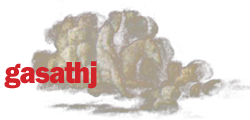The first decade of Computer Graphics
In 1955, when Herbert W. Franke connected the wave signals generated by an analogue computer to an oscilloscope, the history of computer graphics began. The first series of computer graphics work Oszillogramme was published the next year. In 1960, Kurd Alsleben produced math based images through an analogue computer and a plotter. After such activities with analogue computer systems, the computing environment changed and digital computer has become the main platform. Frieder Nake, Georg Nees and Hiroshi Kawano were the primary players of digital computer imaging who had aesthetics in mind in the early 1960s.
Computer graphics has a duality in its purpose. One is the industry oriented imaging, for which numerous innovative devices made debuts and it has still been producing rich fruit in manufacturing and entertainment industries today. The other is art oriented image
Yoshiyuki Abe and Akemi Ishijima
production, which unfortunately seems to have got lost itself in a labyrinth of aesthetics and technology. The border of these properties is ambiguous like the quantum-mechanical property which is regardable as both a wave and a particle. One of the unfortunate side effects of the duality was the prevailing fallacy that a photo-realistic image and a verification of a scientific research can be called work of art, and it has weakened the artistic motive for computer graphics for a long time.
Looking back on the past, we can see that the computer graphics started with a real-time interactive system of analogue computer, but the production scheme changed when the digital system became available for artists. Programming, or algorithmic design became the primary creative process, and the digital pioneers opened a new horizon utilizing Max Bense's informational aesthetics and/or Claude Shannon's communication theory. In the meantime, the output device was a challenging issue for the artists in the very early stage. Various ways to fix images of computer graphics reflected the situation of artists. Photographing or filming of the dancing image on the CRT screen, drawing with a plotter, and gouache onto the line printer paper were the typical methods. Later, the advancement of technology such as full color frame buffer and interactive access method brought on the paradoxical stagnation in the art, since the innovative motivations of the artists of the earlier period had been lost, and the motivation for computer graphics started to resemble that of the other existing visual media such as film or photography.
Computer graphics has distinctive imaging properties, and most of them were explored by the pioneers in the first decade. They developed their activities further, and each had moved on to a new field by the end of the next decade. The prominence of the pioneers featured in this serial is that they practiced the creative activities entirely separate from the industry. The fact that the pioneers’ works of computer graphics were not recognized properly by the people of the art world then, only gives a proof that they were ignorant and incompetent in dealing with the new emerging art.
This note will describe the very first stage of the computer graphics with video clips and images of pioneers in Germany and Japan.
1. Herbert W. Franke (b.1927)
Franke's creative activities are continuing to the present for more than seventy years since he took photos of the statues in the town of Vienna in his early teens. His majors in Physics, Chemistry and Mathematics at Vienna University and his great skill in electronics and photography paved the way to the pioneer of computer graphics. He had first encountered electronic imaging in a research of electron microscope, and the experience of seeing interesting disturbed grid lines by the electron beam inspired him to produce varied Lissajous figure arrangements on an oscilloscope CRT. He photographed them for the series of Lichtformen in the early 1950s. In 1956 the first series of computer graphics work Oszillogramme was produced with analogue computer and oscilloscope, and the succeeding series of Raumstudien (1957) and Elektronische Graphiken (1961) were produced in the same manner.
In 1959 he had the exhibition Experimentelle Aesthetik in the Museum of Applied Arts in Vienna. This show included the photo prints of Lichtformen, computer graphics series and other electronic image works produced by x-rays. This show demonstrated his great interest in electronic visual creation and the magnificent achievement. This show traveled to London, Zurich and Munich later.(3)
With a lot of other track records such as science-fiction novels, images and animations by digital computers, sound creation, math based abstract graphics(4), writings and lectures on art and science, script writing for puppet play and so on, the long-running diversified activity of Franke has been supported by his stance on the creation that he is always looking for other possibilities and by his great curiosity about the new world. He says “I'm always interested in the innovation and changes and looking for different equipment and other possibilities. When I reach the perfect result, I'm not interested in it anymore. I do not want to stay at the same place.”
Oszillogramme, 1956
Elektronische Graphiken, 1961/62 Raumstudien, 1956/57
Image plates:
Herbert W. Franke, Kunst aus dem Computer - apparative und
programmierte Graphik, Kuenstlerhaus, Vienna, 1975.
(c) Herbert W. Franke.
(3)<a href="http://www.art-meets-science.info/experimentelle-aesthetik">http://www.art-meets-science.info/experimentelle-aesthetik/</a>
(4)two images in the video interview are from Die Welt Der Mathematik by Herbert W. Franke and Horst Helbig, VDI Verlag, Dusseldorf, 1988
... to be continued in our next issue.
